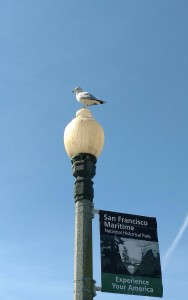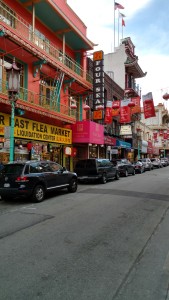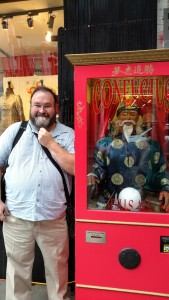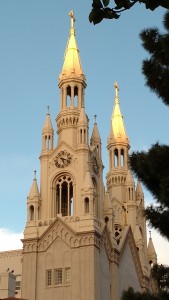Preparing to leave San Francisco was hard, but since we had actually left our hearts in Seattle, we knew we had to move on. A repeat breakfast at the nearby Denny’s set us up for the day.
We packed our suitcases and our memories and headed out of San Francisco across the Bay Bridge bound for Richmond. In Richmond we found the National Park dedicated to preserving the story and contributions of all the Rosies who riveted during the war years while the men were away fighting.
 Located out at the end of the pier where ships were built, a small building was marked as Rosie the Riveter Visitor Center. We were greeted and asked if we wanted to go to the ranger lecture at 11:00. Usually wanting to explore on our own, we tend to dismiss the arranged lectures. But we were assured this was one we did not want to miss. She explained that the ranger giving the talk was a 95 year old woman who had worked at the shipyard when she was 20 years old during the Second World War.
Located out at the end of the pier where ships were built, a small building was marked as Rosie the Riveter Visitor Center. We were greeted and asked if we wanted to go to the ranger lecture at 11:00. Usually wanting to explore on our own, we tend to dismiss the arranged lectures. But we were assured this was one we did not want to miss. She explained that the ranger giving the talk was a 95 year old woman who had worked at the shipyard when she was 20 years old during the Second World War.
We agreed to attend and when Betty Reid Soskin stepped up to the podium and began talking, the room was transfixed. She related her story punctuated by facts and historical realities, saying often, “That’s just the way we were.” She talked for an hour without one note in front of her; without one stumble; or one “ah . . .” and hardly a pause for breath. And the room was rapt.
 One of the stories she told was that her great grandmother had been born a slave in 1846 and lived to see African-American women work along side white women and some men in the war effort before she died in 1946. She went on to explain that even in her own life-time Betty has lived to see old Jim Crow laws abolished and an African-American in the White House. In fact, she’s met that man in the White House and attended his inauguration. She told how when she did attend the inauguration, she carried a picture of her great grandmother in her pocket as she stood in the shadows of the Lincoln Memorial, the man who had been instrumental in granting freedom to her great-grandmother, and listened to an African-American give his inaugural address. “And, if that doesn’t move you,” she said, “Check your pulse.”
One of the stories she told was that her great grandmother had been born a slave in 1846 and lived to see African-American women work along side white women and some men in the war effort before she died in 1946. She went on to explain that even in her own life-time Betty has lived to see old Jim Crow laws abolished and an African-American in the White House. In fact, she’s met that man in the White House and attended his inauguration. She told how when she did attend the inauguration, she carried a picture of her great grandmother in her pocket as she stood in the shadows of the Lincoln Memorial, the man who had been instrumental in granting freedom to her great-grandmother, and listened to an African-American give his inaugural address. “And, if that doesn’t move you,” she said, “Check your pulse.”
 Well, there was no need for me to do that because I was so moved the tears streamed down my cheeks. She was powerful! And, a great example of the need and the value of oral history. We talked with her after her presentation and I asked if I could take her picture. “Of course,” she said. Another woman offered to take the photo so both of us could proudly stand with her. It was an inspiring and grace-filled morning.
Well, there was no need for me to do that because I was so moved the tears streamed down my cheeks. She was powerful! And, a great example of the need and the value of oral history. We talked with her after her presentation and I asked if I could take her picture. “Of course,” she said. Another woman offered to take the photo so both of us could proudly stand with her. It was an inspiring and grace-filled morning.
Over a sandwich and salad at the cafe on the dock next door in one of the old industrial buildings, we couldn’t stop talking about Betty. One phrase I wrote down was her awareness and conclusion that there are “multiple duplicating truths.” That’s a concept to meditate on. No one person has all the truth . . . or holds the only truth. There are multiple duplicating truths. The wisdom of Betty Reid Soskins.
Following lunch we went to the memorial erected to all the women who joined the work force making boats and planes; jeeps, tanks, and trucks, while the men were on the front lines. My grandmother was one of those women! She worked at Douglas Aircraft in the Dope Shop. That was where they prepared and “doped” the muslin fabric that was part of the wings and ailerons of the planes. I spent the next hour wishing I had talked with my grandmother more about her experiences as a women in industry during the war.
 A few miles down the road we switched centuries and visited the home of John Muir in Martinez, CA. We walked through his peach orchard and through the rooms of his house. Most impressive to me was his “office” or “scribble den,” as he called it. That was where he wrote. And it was filled with books and papers all over every surface, as well as the floor. I smiled that someone with such a great mind and a great pen organized his office like I often did! I felt right at home. I think I might have a “scribble den” of my own.
A few miles down the road we switched centuries and visited the home of John Muir in Martinez, CA. We walked through his peach orchard and through the rooms of his house. Most impressive to me was his “office” or “scribble den,” as he called it. That was where he wrote. And it was filled with books and papers all over every surface, as well as the floor. I smiled that someone with such a great mind and a great pen organized his office like I often did! I felt right at home. I think I might have a “scribble den” of my own.
One of the most wonderful aspects of visiting all these historical sites is to be able to stand where famous people have stood. To touch the same banister that John Muir . . . or Abraham Lincoln . . . or Clara Barton touched when they walked up the stairs of their homes. It’s the greatest time travel experience I know of, and I highly recommend it.
The quote from John Muir that struck me today, among the many, many beautiful words he has written, is: “I merely went out for a walk and found that going out was really going in.” How better could one describe the mystical experience of enjoying the beauty of nature?
A lovely Italian dinner in a tiny family restaurant a stone’s throw from the Muir home and we were ready for an evening’s rest at our hotel.
 It was difficult to get out the old computer and peck away last night after we returned home, so this is the memories of yesterday.
It was difficult to get out the old computer and peck away last night after we returned home, so this is the memories of yesterday. We had a pleasant drive through clouds, light rain and some sun, through the central Oregon valley. Quite beautiful country, I must say. At one point between the rain and the sun there was a gorgeous full rainbow that filled the sky. I had to try and capture it – on my phone, no less. It’s barely visible here, but in the sky it was beautiful.
We had a pleasant drive through clouds, light rain and some sun, through the central Oregon valley. Quite beautiful country, I must say. At one point between the rain and the sun there was a gorgeous full rainbow that filled the sky. I had to try and capture it – on my phone, no less. It’s barely visible here, but in the sky it was beautiful.
















 Time for lunch! The closest place looked the best, so we parked ourselves at The Pub BBQ at Ghirardilli square. And, it was delicious. We stopped into the chocolate store afterwards and accepted our complimentary chocolate for desert and we were set for the afternoon.
Time for lunch! The closest place looked the best, so we parked ourselves at The Pub BBQ at Ghirardilli square. And, it was delicious. We stopped into the chocolate store afterwards and accepted our complimentary chocolate for desert and we were set for the afternoon.























